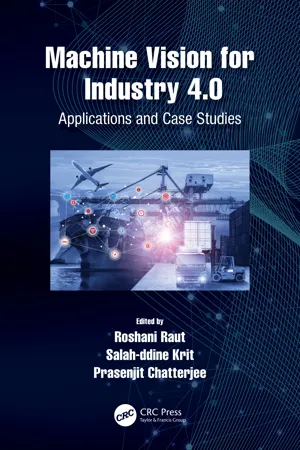
Machine Vision for Industry 4.0
Applications and Case Studies
- 302 pages
- English
- ePUB (mobile friendly)
- Available on iOS & Android
Machine Vision for Industry 4.0
Applications and Case Studies
About this book
This book discusses the use of machine vision and technologies in specific engineering case studies and focuses on how machine vision techniques are impacting every step of industrial processes and how smart sensors and cognitive big data analytics are supporting the automation processes in Industry 4.0 applications.
Industry 4.0, the Fourth Industrial Revolution, combines traditional manufacturing with automation and data exchange. Machine vision is used in the industry for reliable product inspections, quality control, and data capture solutions. It combines different technologies to provide important information from the acquisition and analysis of images for robot-based inspection and guidance.
Features
-
- Presents a comprehensive guide on how to use machine vision for Industry 4.0 applications, such as analysis of images for automated inspections, object detection, object tracking, and more
-
- Includes case studies of Robotics Internet of Things with its current and future applications in healthcare, agriculture, and transportation
-
- Highlights the inclusion of impaired people in the industry, for example, an intelligent assistant that helps deaf-mute individuals to transmit instructions and warnings in a manufacturing process
-
- Examines the significant technological advancements in machine vision for Industrial Internet of Things and explores the commercial benefits using real-world applications from healthcare to transportation
-
- Discusses a conceptual framework of machine vision for various industrial applications
The book addresses scientific aspects for a wider audience such as senior and junior engineers, undergraduate and postgraduate students, researchers, and anyone interested in the trends, development, and opportunities for machine vision for Industry 4.0 applications.
Frequently asked questions
- Essential is ideal for learners and professionals who enjoy exploring a wide range of subjects. Access the Essential Library with 800,000+ trusted titles and best-sellers across business, personal growth, and the humanities. Includes unlimited reading time and Standard Read Aloud voice.
- Complete: Perfect for advanced learners and researchers needing full, unrestricted access. Unlock 1.4M+ books across hundreds of subjects, including academic and specialized titles. The Complete Plan also includes advanced features like Premium Read Aloud and Research Assistant.
Please note we cannot support devices running on iOS 13 and Android 7 or earlier. Learn more about using the app.
Information
Table of contents
- Cover Page
- Half-Title Page
- Title Page
- Copyright Page
- Dedication Page
- Contents
- Preface
- Acknowledgments
- Editors
- Contributors
- Chapter 1 Challenges in Industry 4.0 for Machine Vision: A Conceptual Framework, a Review and Numerous Case Studies
- Chapter 2 Practical Issues in Robotics Internet of Things
- Chapter 3 The Role of Sensing Techniques in Precision Agriculture
- Chapter 4 Perspectives on Deep Learning Techniques for Industrial IoT
- Chapter 5 Proposal for Missing Person Locator and Identifier Using Artificial Intelligence and Supercomputing Techniques
- Chapter 6 Inclusion of Impaired People in Industry 4.0: An Approach to Recognise Orders of Deaf-Mute Supervisors through an Intelligent Sign Language Recognition System
- Chapter 7 A Deep Learning Approach to Classify the Causes of Depression from Reddit Posts
- Chapter 8 Psychiatric Chatbot for COVID-19 Using Machine Learning Approaches
- Chapter 9 An Analysis of Drug-Drug Interactions (DDIs) Using Machine Learning Techniques in the Drug Development Process
- Chapter 10 Image Processing-Based Fire Detection Using IoT Devices
- Chapter 11 Crowd Estimation in Trains by Using Machine Vision
- Chapter 12 Analysis of a Machine Learning Algorithm to Predict Wine Quality
- Chapter 13 Machine Vision in Industry 4.0: Applications, Challenges and Future Directions
- Chapter 14 Industry 5.0: The Integration of Modern Technologies
- Index